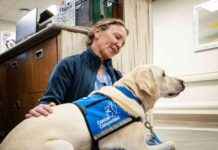After a devastating fall due to a patch of ice, Marc Durocher, a 75-year-old electrician, found himself at a critical juncture following a broken hip and subsequent surgery at UMass Memorial Medical Center. The hospital was no longer the place for him, yet he wasn’t quite prepared to navigate life independently, still grappling with pain and instability. His story mirrors that of countless patients around the country who face the dilemma of being stranded in hospitals due to the unavailability of nursing home and rehabilitation beds.
Rehab at Home: A Welcome Alternative
When Durocher was finally ready for discharge in late January, a unique opportunity presented itself – a chance to participate in a research study at UMass Chan Medical School exploring the innovative concept of “SNF at home”. This novel approach aimed to provide subacute care typically offered at a skilled nursing facility within the patient’s home environment, supported by caregiver visits and remote monitoring technology. Despite initial hesitations, Durocher and his wife, Jeanne, decided to take the leap, enticed by the prospect of recovering in the familiar comfort of their home alongside their loyal companion, Buddy.
Rehab at home initiatives have been gaining traction across various states like New York, Pennsylvania, and Wisconsin, as a response to the growing scarcity of nursing home and rehab beds for patients who are too unwell to return home but not sick enough to warrant prolonged hospital stays. The dire staffing shortages at post-acute facilities nationwide have contributed to a staggering 24% increase in hospital length of stay for patients in need of skilled nursing care over the past three years. This predicament forces these patients to occupy costly hospital beds unnecessarily, leaving others languishing in emergency rooms awaiting admission. In December alone, nearly 1,995 patients in Massachusetts were awaiting discharge from hospitals, painting a stark picture of the urgent need for alternative care solutions.
Challenges and Triumphs of SNF at Home
While the concept of SNF at home offers a glimmer of hope, its implementation has been riddled with obstacles. The absence of federal standards governing the operation of such programs, delineating patient eligibility criteria, and outlining covered services has left these initiatives in a regulatory limbo. Consequently, fee-for-service Medicare and most insurance companies do not extend coverage for home-based subacute care, making it largely inaccessible to the general population. The programs have only taken root in select hospital systems with proprietary insurance entities or those operating under bundled payment models, where providers receive a fixed fee to manage complete episodes of care, as observed in Medicare Advantage plans.
Marc Durocher’s involvement in the clinical trial at UMass Chan Medical School, which facilitated his recovery from hip surgery within the familiar confines of his Auburn, Massachusetts residence, was made possible through a grant from the state Medicaid program. This initiative, backed by state health officials, aimed to reduce healthcare costs, enhance care quality, and streamline patient transitions out of hospitals. The American Health Care Association, representing for-profit nursing homes, has expressed reservations about SNF at home programs, citing legal requirements mandating that such services be administered in institutional settings, along with the unique social and recreational benefits nursing homes offer, which are challenging to replicate at home.
Despite these apprehensions, the success stories emerging from SNF at home programs underscore the transformative impact of personalized, in-home care on patient outcomes. Unlike traditional nursing home settings, patients recuperating at home are more mobile, fostering quicker recovery rates. Wendy Mitchell, medical director of the UMass Chan clinical trial, highlights the significance of tailoring therapy to patients’ home environments, facilitating a seamless transition to independent living. This individualized approach has yielded remarkable results, with the Rehabilitation Care at Home program by Contessa Health reporting zero incidents of bed sores and minimal infections among patients recovering at home, outperforming facility-based care in terms of patient safety and well-being.
In reimagining post-acute care delivery, the UMass and Mass General Brigham studies have faced unique challenges in ensuring patient safety and comfort in home settings. The Massachusetts-based programs have enrolled patients living alone, necessitating innovative solutions to bridge the care gap. The UMass trial adopts a minimalist approach to technology, providing patients with a select range of devices for remote monitoring, coupled with in-person visits by healthcare professionals. By leveraging cutting-edge technology and remote monitoring tools, Mass General Brigham’s study aims to minimize reliance on skilled staff, optimizing patient care while reducing healthcare costs.
The road to recovery for Marc Durocher involved a seamless transition to in-home rehabilitation, marked by dedicated support from a team of healthcare professionals and the comforting presence of his loved ones. As he adapted to the challenges of daily life post-surgery with unwavering determination, the personalized care provided through the SNF at home program offered a sense of security and familiarity that accelerated his healing process. Embracing the transformative potential of home-based care, Durocher’s journey stands as a testament to the evolving landscape of post-acute care delivery, heralding a new era in patient-centered healthcare.

















